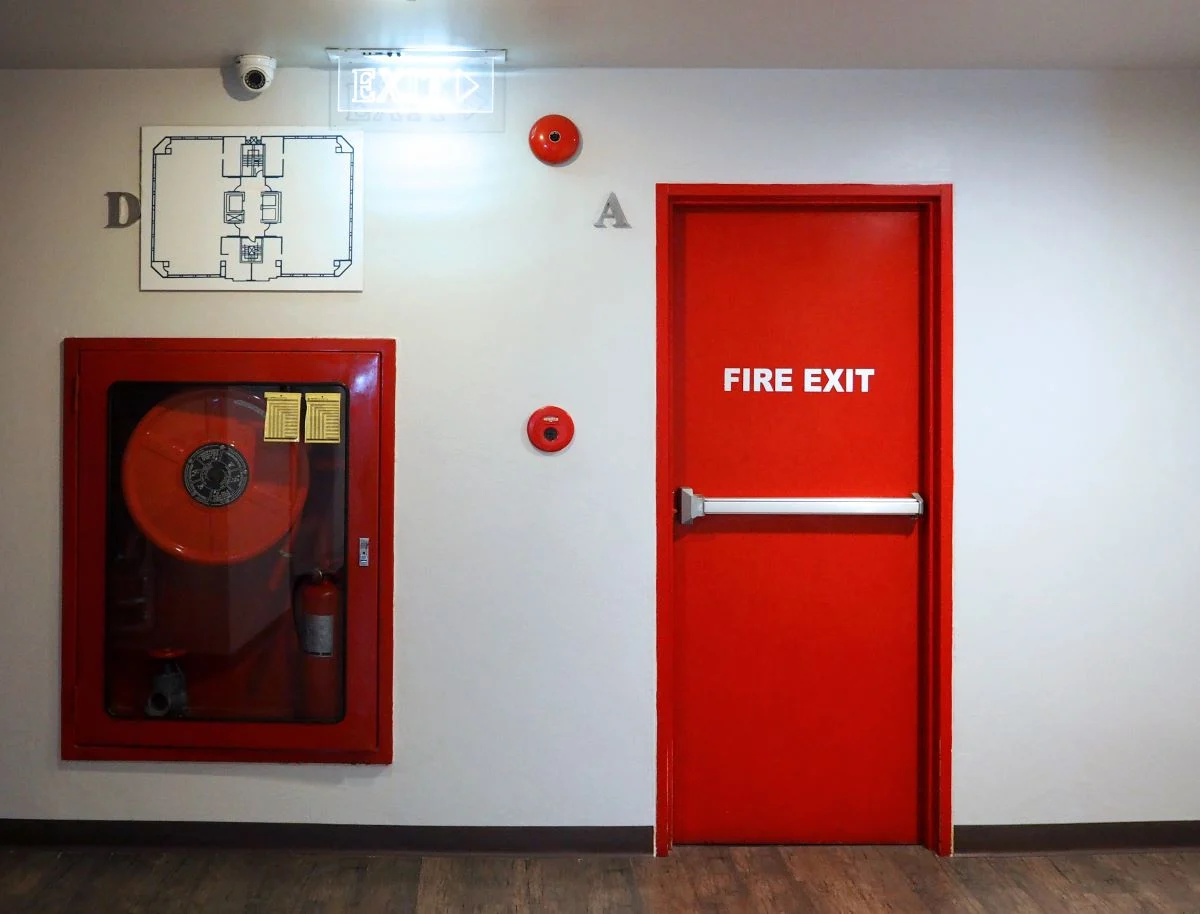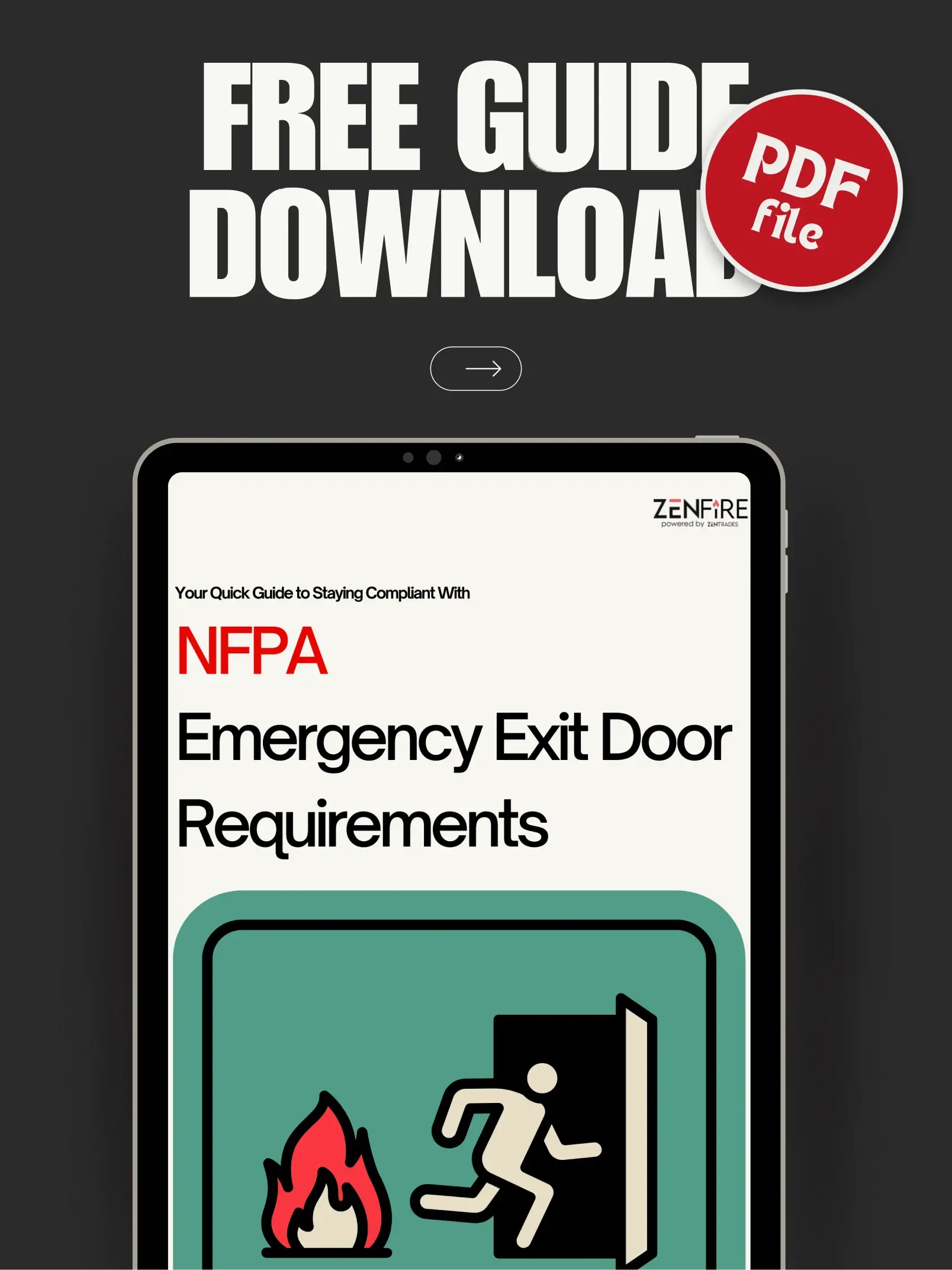Emergency Exit Doors Guidelines And ALL You Need To Know About It
- Field Service Management
- 9 Min Read
Before divulging the extent of everything you need to know about emergency exit doors, let us get a brief overlook of what emergency exits are.
Emergency exit doors are structural elements designed to allow for a quick and secure exit from a building during an emergency. They are also helpful when a standard or unique access is obstructed by fire or residue. Emergency exits are typically found in strategic locations within the structure, such as a hallway, stairwell, or other areas where people can congregate in an emergency.
A regular emergency exit must be marked with a collision bar. Signs directing people to exit doors must be posted so people can find them quickly in times of terror. An alternate emergency exit allows for a quicker and more secure evacuation if there is a bottleneck along the fast route.
Fire code requirements differ significantly from one building to the next, depending on the location, size, and work type. The NFPA’s Life Safety 101 code contains these requirements. NFPA’s fire code covers the number of exits required based on the maximum occupancy of any given area or employees within a business. In emergencies, having a path of exit travel that employees or residents know and can rely on is critical to getting them out safely in a fire. These NFPA exit doors aim to get people out of potentially dangerous situations like smoke, fire, and heat as quickly as possible.
The NFPA has strict guidelines for what these emergency exit doors should look like and how they should function to accomplish this. According to NFPA standards, egress requirements include constructing and placing egress pathways. This helps to ensure consistency across all buildings while also providing employees with the best chance of performing an emergency evacuation safely and on time.
ZenFire has created a knowledge vault for plumbing contractors and technicians like yourself. Head to our website for more informative articles to enhance your business knowledge.
ZenFire field service management software can also streamline and optimize your workflow to generate growth and more revenue for your business!
Book a FREE demo today to start streamlining your workflow!
Here What We Cover
How Do Emergency Exit Doors Work?
Fire exit doors are non-fire-resistant exterior doors that can be left open. While fire doors are intended to keep fires from spreading within the structure, fire exit doors are designed to provide a quick and safe exit from the facility.
Any area in a building must have at least two emergency exits. The exits must not be next to each other. This will reduce the risk for these fire-damaged pathways. Or anything else that makes getting to the door dangerous.
There is something known as the “one-half diagonal rule” for new structures. Thus, the means of egress must be no less than half the diagonal distance of the serviced area.
There must be at least two exits from any balcony, mezzanine, or other areas. The number of doors required must be increased as follows:
- More than 49 but fewer than 500 occupants
- Over 500 but less than 1,000 occupants
- Over 1,000 occupants
- Exceptions are made for existing buildings per the specific occupancy sections of the variety of buildings and life safety codes
The occupant load, or the number of people expected in a building at any given time, is determined by dividing a specific portion of the building’s gross or net floor area by a projected factor for each person. Emergency exit doors in public, commercial, and other workplaces must meet specific requirements. Emergency exit doors that don’t lock from the inside are free of appliances or alarms that could limit access to the exit in an emergency and are extendable.

Use our free invoice template now
Make winning quotes in minutes—for any industry and any job.
Emergency Exit Doors Requirements
An emergency exit must meet the following criteria:
- It should be permanent.
- Easily accessible location
- Well-managed and maintained
- In an emergency, it can gather people.
- The control is on-site.
It is observed during a site inspection that the inspection of an exit route is not always taken seriously. Industry employees face fire, chemical release, or similar disaster risks daily. If such an event occurs, the need to evacuate the premises quickly and safely arises to avoid potentially hazardous consequences.
Exits must be separated by fire-resistant materials, with a one-hour fire-resistance rating and a two-hour fire-resistance rating if the door connects less than or more than three floors, respectively.
Exit discharges must open spaces with outside access, like streets, walkways, refuge areas, or public ways. These exit discharge areas must be sufficiently large to accommodate the building occupants likely to use the exit route.
Specifications Needed On Emergency Exit Doors
There are several specific requirements needed on emergency exit doors that inspectors should familiarize themselves with. Safe egress can save lives in a fire or other emergency, and hence fire inspectors should ensure that all these requirements are met and in place during their regular checkups.
How Fire Doors Keep You Safe in a Fire
A fire-rated door can be made of metal, wood, or glass. It divides space into smaller sectors in certain parts of a building or structure. The larger the design, the more segmented it will be. Thus, if one of the sectors catches fire, the fire-rated door aids in containing the fire and smoke and preventing them from spreading to the building’s other compartments. As a result, its purpose is to prevent fire spread, allow safe building evacuation, and enable faster rescue and fire extinction. In that sense, a fire-rated door is a passive fire protection system.
Get posts like this in your inbox.
Keep learning how to run a 5-star business with our bi-weekly newsletter.
PUSH BAR EMERGENCY EXIT DOORS
A Push Bar is a piece of horizontal hardware installed on a Fire Door. Its spring-type mechanism aids the building’s occupants’ emergency exit.
A fast and easy egress device installed on commercial doors, emergency exits, and fire doors can unlock the door without unlocking maneuvers. The spring-loaded crossbar is fixed horizontally across the interior side of the door. Allowing occupants to easily see the device and use it to open the door outward.
HOW ARE EMERGENCY EXIT DOORS EQUIPPED?
Emergency exit doors are vital for safety in a dangerous situation and must be equipped with certain fundamental parts to be effective in that situation. They are usually equipped with panic bars or push bars that make it easier to open from the inside of a building during a fire emergency.
They are equipped with certain alarms that make a loud noise when opened, to alert the occupants of the building that an emergency is underway and to help them find the exit according to the source of the noise.
A fire escape door usually has an automatic release mechanism that makes sure the exit can be opened from the inside and cannot be opened from the outside (otherwise needed). For this mechanism, locks like a deadbolt lock or an electromagnetic lock, are equipped on a fire escape door for better safety of the occupants.
FAQs
CAN EMERGENCY EXIT DOORS BE OPENED IN FLIGHT
In an emergency, emergency exit doors make it easier to exit the plane. The aircraft doors do not open during the flight due to their nature, but they open when a specific force is applied. Passengers seated near exit doors receive brief instructions on how to use them in an emergency. Only volunteers or people who have chosen to sit near the exit door are permitted.
WHAT IS AN EXIT DISCHARGE?
An exit discharge refers to the segment of an exit pathway that directly connects from the end of an exit to a public area or an open space with outdoor access. Typically, this exit discharge entails an exterior route between the building and the public space, facilitating safe egress.
WHAT ARE THE EXIT DISCHARGE REQUIREMENTS?
The general criteria for exit discharge are outlined in IBC Section 1028.1. In most cases, exits must directly lead to the building’s exterior. The exit discharge should either be at ground level or offer a clear path to ground level for egress. It’s crucial that the exit discharge doesn’t loop back into the building.
According to the IBC definition, exit discharge typically occurs outside the building, providing a route to a public area. However, Section 1028.1 permits two exceptions to this standard. These exceptions allow exit discharge to occur indoors, specifically via interior stairways or ramps leading to an exterior fire escape door, or through a vestibule. Nonetheless, under both exceptions, only up to 50% of the total number and minimum width or capacity of the interior exit stairway or ramp is allowed to pass through these areas at the level of discharge.
WHAT ARE SOME FIRE EGRESS REQUIREMENTS?
Here are some fire egress requirements for spaces in America, mandated by the NFPA’s fire code,
- Number of exits in a space are directly related to the maximum number of occupants in the space.
- There needs to be a set space for the actual construction and arrangement of exit pathways in any space.
- A fire escape door should not have any hindering locking mechanisms installed on them.
- A fire escape door must swing in the direction of exiting the pathway.
- The pathways for exit must lead to paths of safe exit and should never lead into hazardous or risk-prone areas.
IS BLOCKING EMERGENCY EXIT DOORS ALLOWED?
All exit routes must be kept clear. Fire exit doors should never be blocked, even if only temporarily. Exit routes should never be blocked by materials, equipment, or locked doors and should never have dead ends.
Maintaining all safeguards in good working order is necessary to protect employees in an emergency.
CAN EMERGENCY EXIT DOORS BE LOCKED?
Locked or fastened emergency fire doors cannot be easily and immediately opened by anyone who may need to use them in an emergency.
Restricted access to the fire door jeopardizes the route to safety; therefore, all passageways and corridors leading to a fire door should remain permanently unlocked.
What Did We Learn Today?
Emergency exit doors are critical components of a building’s emergency system. As a result, when it’s time for your building’s annual fire and safety inspection, you’ll want a technician who knows what to look for.
A fire safety technician who uses the ZenFire software will never overlook a single aspect of your safety inspection. This is because our software quickly and easily lays out everything the technician needs to know to make your assessment the safest.

Explore a better way to grow your business. Book a free demo now!
Get organized, win jobs, and wow customers.
Book A Free Demo with ZenTrades Today!
Related Reading
Why Your Field Software Management Software Needs QuickBooks Integration
ZenTrades Why Your Field Service Management Software Needs QuickBooks Integration Read More Request Demo...
Read MoreZenTrades How To Manage Electrical Service Agreements Like...
Read MoreZenTrades The Best 5 Jobber Alternatives In 2023...
Read More


